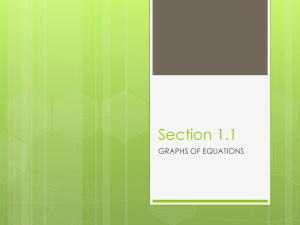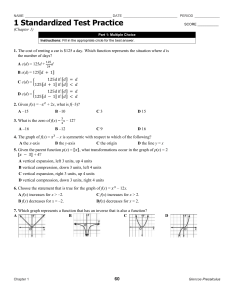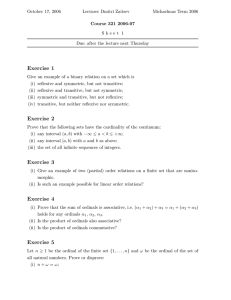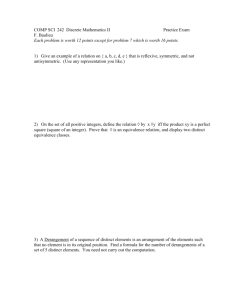FINITE SETS AND SYMMETRIC SIMPLICIAL SETS MARCO GRANDIS
advertisement
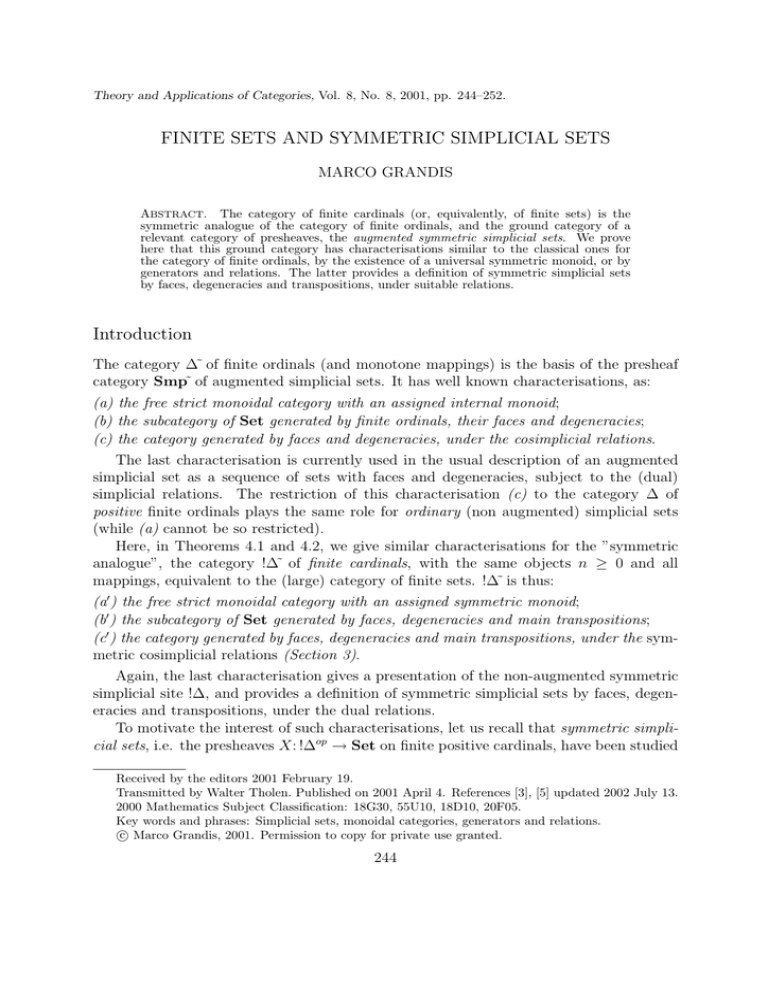
Theory and Applications of Categories, Vol. 8, No. 8, 2001, pp. 244–252.
FINITE SETS AND SYMMETRIC SIMPLICIAL SETS
MARCO GRANDIS
ABSTRACT. The category of finite cardinals (or, equivalently, of finite sets) is the
symmetric analogue of the category of finite ordinals, and the ground category of a
relevant category of presheaves, the augmented symmetric simplicial sets. We prove
here that this ground category has characterisations similar to the classical ones for
the category of finite ordinals, by the existence of a universal symmetric monoid, or by
generators and relations. The latter provides a definition of symmetric simplicial sets
by faces, degeneracies and transpositions, under suitable relations.
Introduction
The category ∆˜ of finite ordinals (and monotone mappings) is the basis of the presheaf
category Smp˜ of augmented simplicial sets. It has well known characterisations, as:
(a) the free strict monoidal category with an assigned internal monoid;
(b) the subcategory of Set generated by finite ordinals, their faces and degeneracies;
(c) the category generated by faces and degeneracies, under the cosimplicial relations.
The last characterisation is currently used in the usual description of an augmented
simplicial set as a sequence of sets with faces and degeneracies, subject to the (dual)
simplicial relations. The restriction of this characterisation (c) to the category ∆ of
positive finite ordinals plays the same role for ordinary (non augmented) simplicial sets
(while (a) cannot be so restricted).
Here, in Theorems 4.1 and 4.2, we give similar characterisations for the ”symmetric
analogue”, the category !∆˜ of finite cardinals, with the same objects n ≥ 0 and all
mappings, equivalent to the (large) category of finite sets. !∆˜ is thus:
(a ) the free strict monoidal category with an assigned symmetric monoid;
(b ) the subcategory of Set generated by faces, degeneracies and main transpositions;
(c ) the category generated by faces, degeneracies and main transpositions, under the symmetric cosimplicial relations (Section 3).
Again, the last characterisation gives a presentation of the non-augmented symmetric
simplicial site !∆, and provides a definition of symmetric simplicial sets by faces, degeneracies and transpositions, under the dual relations.
To motivate the interest of such characterisations, let us recall that symmetric simplicial sets, i.e. the presheaves X: !∆op → Set on finite positive cardinals, have been studied
Received by the editors 2001 February 19.
Transmitted by Walter Tholen. Published on 2001 April 4. References [3], [5] updated 2002 July 13.
2000 Mathematics Subject Classification: 18G30, 55U10, 18D10, 20F05.
Key words and phrases: Simplicial sets, monoidal categories, generators and relations.
c Marco Grandis, 2001. Permission to copy for private use granted.
244
Theory and Applications of Categories, Vol. 8, No. 8
245
in [4, 5], where a combinatorial homotopy theory has been introduced for their category
op
!Smp = Set!∆ , extending a previous theory for simplicial complexes [3].
As a crucial advantage of the extension, we have a fundamental n-groupoid functor
Πn : !Smp → n-Gpd (n ≤ ω) left adjoint to a symmetric nerve Mn , which yields a
strong, simple version of the Seifert-van Kampen theorem: Πn preserves all colimits.
Analogously, a notion of (non-reversible) directed homotopy has been developed in the
ordinary simplicial topos Smp, with applications to image analysis as in [3]; we have now
a fundamental n-category functor ↑Πn , left adjoint to a nerve Nn .
A classical reference on simplicial sets is May’s book [11]. The characterisations of
the category ∆˜ of finite ordinals can be found in Mac Lane’s text [10]. For monoidal
categories, see [10] and Kelly’s book [8]. The case n = 1 of the adjunction Πn Mn was
already noted by Lawvere [9], and was at the origin of this research.
Notation. As usual, finite ordinals and finite cardinals coincide, and are constructed as
0 = ∅, n = (n − 1) ∪ {n − 1} = {0, 1, . . . n − 1}. The term ”graph” stands for oriented
graph.
1. Reviewing the simplicial site
The category ∆˜ of finite ordinals has a rich structure (cf. [10], VII.5, where ∆˜, ∆ are
written as ∆, ∆+ , respectively); it is reviewed here as a leading frame for our symmetric
analogue.
To begin with, ∆˜ is a strict monoidal category, with respect to the ordinal sum m + n
(non-symmetric). The object 1 is an internal monoid
∂:0→1←2:e
e(∂ + 1) = id = e(1 + ∂),
e(e + 1) = e(1 + e)
(1)
with unit (or face) ∂ and multiplication (or degeneracy) e. Then, the terminal mapping
e(k) : k → 1 appears to be an iterated multiplication, with
e(0) = ∂,
e(1) = id,
e(2) = e,
e(3) = e(e + 1) = e(1 + e)), ...
and each monotone mapping f : m → n can be uniquely decomposed as a sum f = e(m0 ) +
... + e(mn−1 ) of iterated multiplications, where mi = #(f −1 {i}), and m = m0 + ... + mn−1 .
The usual (co)faces and (co)degeneracies can be constructed with the structural maps
∂, e and the monoidal structure (for 0 ≤ i ≤ n)
∂in = i + ∂ + (n − i): n → n + 1,
eni = i + e + (n − i): n + 2 → n + 1
(2)
(the injective monotone map which omits i and the surjective monotone map which repeats
i, respectively); the cosimplicial relations follow easily from the previous formulae:
∂i ∂j = ∂j+1 ∂i (i ≤ j),
ej ∂i = ∂i ej−1 , or 1, or ∂i−1 ej
ej ei = ei ej+1 (i ≤ j),
(i < j or i = j, j + 1 or i > j + 1).
(3)
Theory and Applications of Categories, Vol. 8, No. 8
246
A monotone mapping f : m → n has a canonical factorisation
f = ∂j1 · ∂j2 · ... · ei2 · ei1
(m − 1 > i1 > i2 > ... ≥ 0; n > j1 > j2 > ... ≥ 0)
(4)
by faces and degeneracies; every composite of faces and degeneracies can be put in canonical form, using the cosimplicial relations as rewriting rules (from the left).
Taking advantage of all this, the category ∆˜ of finite ordinals is characterised as:
(a) the free strict monoidal category with an assigned internal monoid, 1;
(b) the subcategory of Set generated by finite ordinals, their faces and degeneracies;
(c) the category generated by the graph (2), subject to the cosimplicial relations (3).
2. Symmetric monoids
The category !∆˜ of finite cardinals (equivalent to the category of finite sets) has a strict
monoidal structure m + n, the (categorical) sum of cardinals, with a canonical symmetry
(provided by the sum)
s: m + n → n + m,
s(i) = n + i (0 ≤ i < m),
s(m + j) = j
(0 ≤ j < n)
(5)
which is not strict (note that the identity m + n = n + m is not natural). Now, (1; ∂, e)
is a commutative monoid within this enriched structure, satisfying the obvious axioms
e(∂ + 1) = id = e(1 + ∂),
e(e + 1) = e(1 + e),
es = e.
(6)
However, we want to be able to deal with ”commutative” (or symmetric) monoids,
within a mere monoidal category without symmetry (which is necessary for symmetric
monads, cf. Section 6); this can be done by transferring the symmetry to the monoid
itself. The object 1 is now viewed as an internal symmetric monoid, with a unit (or face)
∂, multiplication (or degeneracy) e and symmetry s,
∂:0→1←2:e
s: 2 → 2
(s(t) = 1 − t),
(7)
satisfying the axioms below (containing a Yang-Baxter condition on s, see [7] and references therein)
e(∂ + 1) = id = e(1 + ∂), e(e + 1) = e(1 + e),
ss = 1,
(s + 1)(1 + s)(s + 1) = (1 + s)(s + 1)(1 + s),
s(∂ + 1) = 1 + ∂,
es = e,
s(1 + e) = (e + 1)(1 + s)(s + 1).
(8)
(In the previous case the four new identities hold automatically, by the coherence theorem
of symmetric monoidal categories and by naturality of s.)
Theory and Applications of Categories, Vol. 8, No. 8
247
3. The symmetric site
After higher faces and degeneracies, we can also construct in !∆˜ the main transpositions
si (the permutation which exchanges i, i + 1, for 0 ≤ i ≤ n)
si = sni = i + s + (n − i): n + 2 → n + 2
(9)
subject to the Moore relations:
si · si = 1,
si · sj · si = sj · si · sj (i = j − 1),
si · sj = sj · si (i < j − 1).
(10)
This is precisely the usual Moore presentation of the symmetric group Sn+2 , the group
of automorphisms of the set n + 2: generators si = (i, i + 1), subject to the relations (10);
see Coxeter-Moser [2], 6.2; or Johnson [6], Section 5, Thm. 3. (Sn+2 also admits systems
of two generators, e.g. the cyclic permutation (0, 1, ... n + 1) and s0 = (0, 1); but then,
the relations are complicated, cf. [2].)
Now, faces, degeneracies and main transpositions form a system of generators for ∆˜:
an arbitrary mapping f : m → n can be factorised as
f = h · ρ,
h = f0 + ... + fn−1 ,
(fj = e(mj ) : mj → 1,
mj = #(f −1 {j}))
(11)
where ρ: m → m is a permutation and h is monotone; the latter is uniquely determined
by f , as above, while ρ is not unique, generally: hρ = hσ iff hρσ −1 = h, iff ρσ −1
can be decomposed in a sum of permutations σ0 + ... + σn−1 , coherently with the setdecomposition m = m0 + ... + mn−1 . (However, ρ is uniquely determined if we ask that
ρ−1 be strictly monotone on each interval of the preceding decomposition of m; then,
depending on conventions, ρ and ρ−1 are respectively called an (m0 , ... mn−1 )-shuffle and
an (m0 , ... mn−1 )-deal, or vice versa.)
Our generators satisfy the symmetric cosimplicial relations, consisting:
- of the usual cosimplicial relations for faces and degeneracies (3),
- of the Moore relations for transpositions (10),
- of the following mixed relations
s i ∂j = ∂j s i ,
si ∂i = ∂i+1 ,
si ∂j = ∂j si−1 ,
si ej = ej si
si ei = ei+1 si si+1 ,
si ej = ej si+1
ei si = ei ,
(i < j − 1),
(12)
(i > j),
(13)
which again follow easily from the structural properties (8).
It follows easily that si ∂i+1 = ∂i and si ei+1 = ei si+1 si , so that the previous relations
(12) can be viewed as rewriting rules for si ∂j : n + 1 → n + 2 and si ej : n + 3 → n + 2
(i ≤ n; j ≤ n + 1), which allow one to transfer permutations to the right of monotone
maps.
Theory and Applications of Categories, Vol. 8, No. 8
248
In general, given a strict monoidal category (A, +, 0) and an internal symmetric
monoid (a; ∂, e, s), the ”multiples” a+...+a are linked by a system of maps (for 0 ≤ i ≤ n)
eni
sni
∂in = ia + ∂ + (n − i)a: na → (n + 1)a,
= ia + e + (n − i)a: (n + 2)a → (n + 1)a,
= ia + s + (n − i)a: (n + 2)a → (n + 2)a,
(14)
which satisfies the symmetric cosimplicial relations. As in Section 1, we write e(n) : na → a
the n-ary multiplication, inductively defined as
e(0) = ∂,
e(1) = id,
e(n+1) = e(e(n) + 1) = e(1 + e(n) );
(15)
one can easily deduce from (13), by induction, that e(n) · sn−2
= e(n) .
i
4. Main results
4.1. Theorem. (The internal symmetric monoid) !∆˜ can be characterised as:
(a ) the free strict monoidal category with an assigned symmetric monoid, 1.
Proof. Let a strict monoidal category (A, +, 0) be given, together with an internal
symmetric monoid (a; ∂, e, s); we have to show that there is a unique strictly monoidal
functor F : !∆˜ → A sending 1 to a and preserving the structure. We already know that
the ”multiples” a + ... + a form a symmetric cosimplicial object (14). From Section 1,
there is a unique strictly monoidal functor F : ∆˜ → A sending 1 to a and preserving unit
and multiplication; it operates in the obvious way on generators
F (n) = na,
F (∂in ) = ∂in ,
F (eni ) = eni .
(16)
Consider now the group Sn+2 of automorphisms of n + 2 in !∆˜; on the main transpositions sni = i + s + (n − i): n + 2 → n + 2 we must have
F (sni ) = ia + s + (n − i)a = sni : (n + 2)a → (n + 2)a;
(17)
on the other hand, since this setting is consistent with the Moore relations (10), we have
defined a sequence of group-homomorphisms F : Sn+2 → Aut((n + 2)a), and extended the
functor F to all bijections of !∆˜.
Take now an arbitrary mapping f = hρ: m → n, factorised as above (11): h is
monotone and ρ is a permutation; we must set F f = F h · F ρ; to show that the definition
is correct, it is sufficient to verify that F h = F h · F si , for each main transposition si
”acting within a summand” of m0 + ... + mn−1 ; taking for instance 0 ≤ i < m0 − 1, we
have (also by the identity e(n) · sin−2 = e(n) , at the end of Section 3)
F h · F si = (F f0 + ... + F fn−1 ) · F si = (F f0 · F si ) + ... + F fn−1 = F h.
(18)
Theory and Applications of Categories, Vol. 8, No. 8
249
Last, we must prove that the extended mapping F preserves composition; let us begin
showing that, for each monotone mapping h: m → n and each permutation σ: n → n
m _ τ_ _/ m
h
(19)
n
σ
k
/n
one can find a permutation τ : m → m and a monotone k: m → n such that the square
above commutes, as well as its F -image in A. One can assume that σ = si ; let h = hu ·...·h1
be the canonical factorisation of a monotone map (4); applying the rewriting rules deriving
from the mixed relations (12), we obtain a factorisation σh = kτ , with a monotone map
k = kv · ... · k1 (canonical factorisation (4)) and a permutation τ = τw · ... · τ1 (product
of main transpositions). The same relations hold in A (for its ∂in , eni , sni ) and F preserves
the composition within monotone maps and within bijections, whence
F σ · F h = F σ · F hu · ... · F h1 = F kv · ... · F k1 · F τw · ... · F τ1 = F k · F τ.
(20)
Now, the functorial property for F follows easily: if the mappings f = hρ: m → n and
f = h σ: n → p are factorised as above, in (11), we rewrite σh = k · τ as in diagram (19),
and
F f · F f = F h · F σ · F h · F ρ = F h · F k · F τ · F ρ = F (h k) · F (τ ρ) = F (f f ).
(21)
(For the last equality, note that (h k) · (τ ρ) = h σ · hρ = f f is an admissible factorisation
of f f , i.e. a permutation followed by a monotone map.)
4.2. Theorem. (Presentation). The category !∆˜ can also be characterised as:
(b ) The subcategory of Set generated by faces (∂i : n → n + 1), degeneracies (ei : n + 2 →
n + 1) and main transpositions (si : n + 2 → n + 2), where 0 ≤ i ≤ n.
(c ) The category generated by faces, degeneracies and main transpositions, under the
symmetric cosimplicial relations (Section 3).
Proof. (b ) is already known and (c ) follows easily from the previous characterisation
(Theorem 4.1). Let !∆˜ be defined by the presentation above. It is strictly monoidal:
define the sum-functor in the obvious way (∂i + q = ∂i , p + ∂i = ∂p+i , etc.) and check
the consistency with relations. Then take a strict monoidal category (A, +, 0) with an
internal symmetric monoid (a; ∂, e, s); a strict monoidal functor F : !∆˜ → A sending 1
to a and preserving the structure is uniquely determined on generators, as in (16), (17):
F (n) = na, F (∂in ) = ia + ∂ + (n − i)a, etc. Conversely, defining F in this way is obviously
consistent with relations, since all of them can be deduced from the axioms (8) and the
monoidal structure.
Theory and Applications of Categories, Vol. 8, No. 8
250
5. Symmetric simplicial sets
Of course, the (non-augmented) symmetric simplicial site !∆ can be presented as the category generated by faces, degeneracies and main transpositions between positive cardinals,
under the restricted relations.
Therefore, a symmetric simplicial set X: !∆op → Set can be assigned by the corresponding data (Xn , ∂in , eni , sni ), where we write Xn = X[n] = X(n + 1), as usual; faces,
degeneracies and main transpositions (for 0 ≤ i ≤ n)
∂in : Xn → Xn−1 ,
eni : Xn → Xn+1 ,
sni : Xn+1 → Xn+1
(22)
are to satisfy the symmetric simplicial relations (dual to the ones considered in Section 3).
Equivalently, one can assign a simplicial set (Xn , ∂in , eni ) and a right action of each symmetric group Sn+1 on the component Xn (xρ = ρ∗ (x)), coherently with faces and degeneracies
(i.e., the latter have to satisfy the dual mixed relations with the main transpositions, cf.
(12), (13)).
The usual embedding of ∆ in Top extends easily to !∆, forming a symmetric cosimplicial object with the same components, the standard topological simplices !∆n = ∆n ,
and extended actions λ∗ (for all mappings λ: m → n )
(!∆n , λ∗ ): !∆ → Top,
λ∗ ((ti )i=0,... n ) = (
ti )j=0,... m .
(23)
λi=j
This model of !∆ in Top gives rise to the functor !S∗ of symmetric singular simplices
!S∗ : Top → !Smp,
!Sn (X) = Top(!∆n , X)
(24)
where the transposition sni : !Sn+1 (X) → !Sn+1 (X) amounts to a reflection of simplices,
with respect to the symmetry hyperplane of the i-th, (i + 1)-th vertices of ∆n .
Its left adjoint is the (symmetric) geometric realisation
functor !Smp → Top : the
[n]
Xn ·!∆n (of the inner functor
realisation of the symmetric simplicial set X is the coend
op
!∆ ×!∆ → Top). By Yoneda, the realisation of !∆[n] is !∆n = ∆n .
6. Symmetric comonads
A comonad (K, ∂, e) in the category A is a comonoid in the category End(A) of endomorphisms of A, with the strict monoidal structure of composition
∂: K → 1,
∂K · e = idK = K∂ · e
e: K → K 2 ,
eK · e = Ke · e;
(25)
it generates an augmented simplicial object in End(A), and - by evaluation - a functor
K∗ : A → Smp˜(A) with values in the category of augmented simplicial objects on A (cf.
[1])
K∗ (X) = ((Kn+1 (X)), (∂in ), (eni )) (n ≥ −1; 0 ≤ i ≤ n),
(26)
eni = K n−i eK i : K n+1 → K n+2 .
∂in = K n−i ∂K i : K n+1 → K n ,
Theory and Applications of Categories, Vol. 8, No. 8
251
For a category C, the category of augmented simplicial objects Smp˜(C) has a well
known comonad, given by the shift (or decalage) K
K: Smp˜(C) → Smp˜(C),
∂: KX → X,
e: KX → K2 X,
n+1
), (en+1
KX = ((Xn+1 ), (∂i+1
i+1 ))n≥−1 ,
n+1
∂ = ∂0 : Xn+1 → Xn ,
e = en+1
: Xn+1 → Xn+2
0
(27)
with counit ∂ and comultiplication e consisting of the discarded faces and degeneracies.
In fact, Smp˜(C) is the cofree category-with-comonad on C, with respect to the forgetful functor | − | from categories with a comonad to categories. The counit-component
|Smp˜(C)| → C sends the augmented simplicial object X to X−1 , while the unit-component
A → Smp˜(|A|) is the functor K∗ considered above.
Similarly, a symmetric comonad (K, ∂, e, s) will be a symmetric comonoid in End(A):
with respect to the previous structure, in (25), we have to add a symmetry s: K 2 → K 2 ,
satisfying
ss = 1,
sK · Ks · sK = Ks · sK · Ks,
(28)
∂K.s = K∂,
se = e,
eK · s = Ks · sK · Ke.
By the characterisation theorems of Section 4, it generates an augmented symmetric
simplicial object in End(A) and a functor K∗ : A → !Smp˜(A). Again, !Smp˜(C) is the
cofree category with symmetric comonad over C.
References
[1] M. Barr and J. Beck, Homology and standard constructions, in: Seminar on triples
and categorical homology theory, Lecture Notes in Math. 80, Springer 1969, 245-335.
[2] H.S.M. Coxeter and W.O.J. Moser, Generators and relations for discrete groups,
Springer, Berlin 1957.
[3] M. Grandis, An intrinsic homotopy theory for simplicial complexes, with applications
to image analysis, Appl. Categ. Structures 10 (2002), 99-155.
[4] M. Grandis, Simplicial toposes and combinatorial homotopy, Dip. Mat. Univ. Genova,
Preprint 400 (1999).
[5] M. Grandis, Higher fundamental functors for simplicial sets, Cahiers Topologie Geom.
Differentielle Categ XLII (2001), 101-136.
[6] D.L. Johnson, Topics in the theory of presentation of groups, Cambridge Univ. Press,
Cambridge 1980.
[7] A. Joyal and R. Street, Braided tensor categories, Adv. Math. 102 (1993), 20-78.
[8] G.M. Kelly, Basic concepts of enriched category theory, Cambridge University Press,
1982.
Theory and Applications of Categories, Vol. 8, No. 8
252
[9] F.W. Lawvere, Toposes generated by codiscrete objects, in combinatorial topology and
functional analysis, Notes for Colloquium lectures given at North Ryde, NSW, Aus
(1988), at Madison, Wisconsin, USA (1989), and at Seminario Matematico e Fisico,
Milano, Italy (1992).
[10] S. Mac Lane, Categories for the working mathematician, Springer 1971.
[11] J.P. May, Simplicial objects in algebraic topology, Van Nostrand 1967.
Dipartimento di Matematica, Università di Genova
Via Dodecaneso 35, 16146-Genova, Italy
Email: grandis@dima.unige.it
This article may be accessed via WWW at http://www.tac.mta.ca/tac/ or by anonymous ftp at ftp://ftp.tac.mta.ca/pub/tac/html/volumes/8/n8/n8.{dvi,ps}
THEORY AND APPLICATIONS OF CATEGORIES (ISSN 1201-561X) will disseminate articles that
significantly advance the study of categorical algebra or methods, or that make significant new contributions to mathematical science using categorical methods. The scope of the journal includes: all areas of
pure category theory, including higher dimensional categories; applications of category theory to algebra,
geometry and topology and other areas of mathematics; applications of category theory to computer
science, physics and other mathematical sciences; contributions to scientific knowledge that make use of
categorical methods.
Articles appearing in the journal have been carefully and critically refereed under the responsibility
of members of the Editorial Board. Only papers judged to be both significant and excellent are accepted
for publication.
The method of distribution of the journal is via the Internet tools WWW/ftp. The journal is archived
electronically and in printed paper format.
Subscription information. Individual subscribers receive (by e-mail) abstracts of articles as
they are published. Full text of published articles is available in .dvi, Postscript and PDF. Details will
be e-mailed to new subscribers. To subscribe, send e-mail to tac@mta.ca including a full name and
postal address. For institutional subscription, send enquiries to the Managing Editor, Robert Rosebrugh,
rrosebrugh@mta.ca.
Information for authors. The typesetting language of the journal is TEX, and LATEX is the
preferred flavour. TEX source of articles for publication should be submitted by e-mail directly to an
appropriate Editor. They are listed below. Please obtain detailed information on submission format and
style files from the journal’s WWW server at http://www.tac.mta.ca/tac/. You may also write to
tac@mta.ca to receive details by e-mail.
Editorial board.
John Baez, University of California, Riverside: baez@math.ucr.edu
Michael Barr, McGill University: barr@barrs.org, Associate Managing Editor
Lawrence Breen, Universit e Paris 13: breen@math.univ-paris13.fr
Ronald Brown, University of North Wales: r.brown@bangor.ac.uk
Jean-Luc Brylinski, Pennsylvania State University: jlb@math.psu.edu
Aurelio Carboni, Università dell Insubria: aurelio.carboni@uninsubria.it
P. T. Johnstone, University of Cambridge: ptj@dpmms.cam.ac.uk
G. Max Kelly, University of Sydney: maxk@maths.usyd.edu.au
Anders Kock, University of Aarhus: kock@imf.au.dk
F. William Lawvere, State University of New York at Buffalo: wlawvere@acsu.buffalo.edu
Jean-Louis Loday, Universit e de Strasbourg: loday@math.u-strasbg.fr
Ieke Moerdijk, University of Utrecht: moerdijk@math.uu.nl
Susan Niefield, Union College: niefiels@union.edu
Robert Par e, Dalhousie University: pare@mathstat.dal.ca
Andrew Pitts, University of Cambridge: Andrew.Pitts@cl.cam.ac.uk
Robert Rosebrugh, Mount Allison University: rrosebrugh@mta.ca, Managing Editor
Jiri Rosicky, Masaryk University: rosicky@math.muni.cz
James Stasheff, University of North Carolina: jds@math.unc.edu
Ross Street, Macquarie University: street@math.mq.edu.au
Walter Tholen, York University: tholen@mathstat.yorku.ca
Myles Tierney, Rutgers University: tierney@math.rutgers.edu
Robert F. C. Walters, University of Insubria: walters@fis.unico.it
R. J. Wood, Dalhousie University: rjwood@mathstat.dal.ca



